- Home
- Sustainability Report
- Environment
- Resource Recycling Initiatives
- Waste Reduction and Recycling in the Housing Business
Waste Reduction and Recycling in the Housing Business
Efforts at New Housing Construction Sites
Reduction Rate of Industrial Waste Generated at New Housing Construction Sites
Since 2014, Sumitomo Forestry has launched a "waste reduction working" by personnel in charge of product development, material procurement, production control, and environment department, and has devised and implemented many measures to reduce waste at new construction sites.
We discovered two-thirds of all our waste is made up of wood waste, gypsum board and cardboard from detailed data about the waste that is produced aggregated from the industrial waste management system used under this inter-region certification, which has been in operation since 2012. We have worked to reduce waste by concentrating on these three primary forms of waste.
Promote Pre-cutting of Construction Materials
The Mid-Term Sustainability Targets of the Sumitomo Forestry Group set a target of reducing the amount of industrial waste generated per building from new housing construction sites to 2,511 kg/building by fiscal 2024. In fiscal 2021, we began to use pre-cut roofing slates and Kizure Panels at our branches and offices nationwide, and this has gradually had a positive effect on reducing industrial waste emissions. In fiscal 2023, among the well-established pre-cut operations, it has become possible to handle sloped roof shapes with roof slate material that was not possible to pre-cut in the past, and industrial waste emissions steadily decreased to 2,467 kg per building, exceeding the fiscal 2023 target of 2,709 kg.
With respect to Kizure Panels and roof slate material, we are seeing steady results, reducing them by 80kg/building and 170 kg/building, respectively. In addition, in fiscal 2023, we expanded the area of operation for pre-cutting of siding, and the reduction effect from this has steadily increased. At 550 kg per building, the weight of waste from siding is considerable and the number of projects using siding continues to increase with each passing year. As a result, we expect to further reduce industrial waste emissions through expanded operation of pre-cutting in the future.
In addition, at construction sites, we aim to reduce industrial waste emissions by 2.5% from the actual emissions in fiscal 2023 by promoting the use of reusable protection materials and ordering appropriate quantities of construction materials to prevent the generation of surplus materials, etc.
Reduction Rate of Industrial Waste Generated at New Housing Construction Sites
(Per Household)
| Total Emissions (kg) | Reduction Rate (Compared to Baseline) | |
|---|---|---|
| FY2017 (Baseline) |
3,325 | - |
| FY2021 result | 2,736 | ▲18% |
| FY2022 result | 2,585 | ▲22% |
| FY2023 result | 2,467 | ▲26% |
Initiative for Recycling of Industrial Waste Generated at New Housing Construction Sites
Sumitomo Forestry meticulously sorts waste produced on new housing construction sites. We will raise awareness through mediums such as posters including specific waste information to make sorting of the 11 categories of waste easier. We have also engaged in efforts to reuse rather than dispose of wood base and packing materials used when transporting precut structural and other materials.
In fiscal 2023, the operation of pre-cutting of Kizure Panels and roof slates progressed, and the generation of industrial waste of wood waste and slates, which used to be recycled, decreased, and this affected the recycling rate that it declined and stagnated at 95.1%, compared to the recycling rate target of 98%.
Currently, the Sumitomo Forestry Group sets a goal of achieving 98% waste recycling rate for new housing construction sites by fiscal 2024 as part of the Mid-Term Sustainability Targets.
In fiscal 2024, we will reduce composite waste and improve the recycling rate by further enforcing separation of waste on site. We will also work to expand the adoption of new recycling treatment plants.
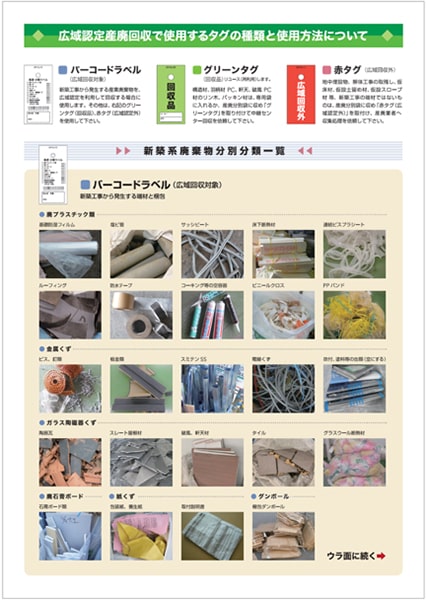
Posters About Sorting Industrial Waste
Waste Recycling Rate at New Housing Construction Sites*
| Recycling Rate | |
|---|---|
| FY2017 (Baseline) |
92.5% |
| FY2020 result | 95.2% |
| FY2021 result | 95.1% |
| FY2022 results | 94.3% |
| FY2023 results | 95.3% |
*Housing Division only
Recycling Rate at New Housing Construction Sites
(Housing Division, Construction Business Sub-Division, Sumitomo Forestry Landscaping, Sumitomo Forestry Home Engineering)
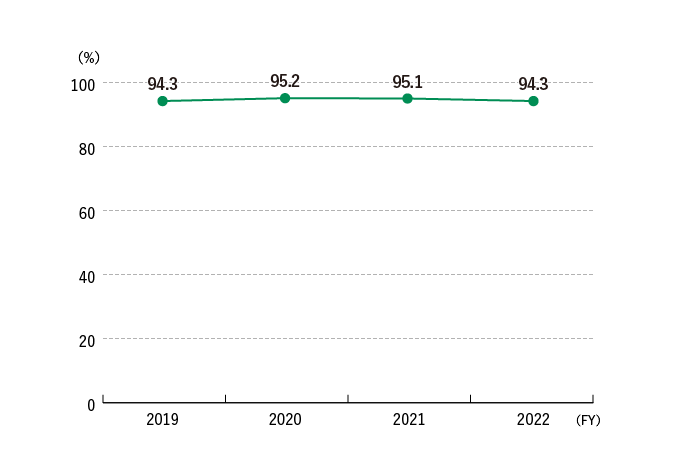
Acquisition of the Inter-Region Recovery and Recycling Certification by the Ministry of Environment
Sumitomo Forestry has been certified by the Ministry of the Environment under Inter-Region Recovery and Recycling Certification. This certification makes it possible for non-industrial waste companies to transport industrial waste, and we have built our own industrial waste recycling system.
Our industrial waste management system for new housing construction sites helps contribute to the rationalization of waste disposal by using returning transportation for collecting waste while also securing traceability by applying bar codes to waste and collecting accurate data about the volume of waste generated.
Operations at the Metropolitan Area Recycling Center
Sumitomo Forestry has used the acquisition of the inter-region recovery and recycling certification to establish the Metropolitan Area Recycling Center in Kazo, Saitama Prefecture for advanced sorting and data collection. The Metropolitan Area Recycling Center has been collecting and processing waste produced by new housing construction sites of the metropolitan and five prefectures of Kanto (Metropolitan Tokyo, Kanagawa, Saitama, Ibaraki, Tochigi, and Gunma prefectures).
The Metropolitan Area Resource Recovery Center collects detailed data regarding waste generation conditions and trends by specification, construction contractor, and region, and utilizes the data in product development, material procurement, and production management departments for use in waste reduction initiatives.
This initiative works to expand operation under the certification even in regions outside the metropolitan area. Currently, the system is in operation at branches except in the San-in area. In the same way data is collected by the Metropolitan Area Recycling Center, we can also gather data on the level of waste produced throughout Japan. The analysis of this data helps us reduce waste because we can discover trends in the amount and type of waste according to building specifications and construction conditions in each region.
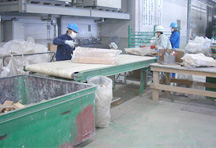
Metropolitan Area Recycling Center
Flow of Industrial Waste Collection Using the Inter-Region Recovery and Recycling Certification
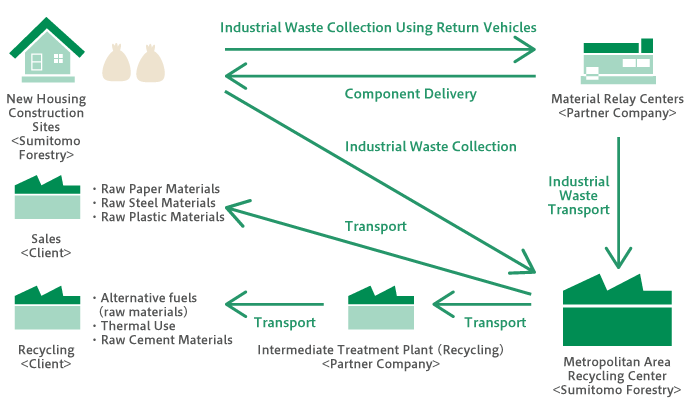
Breakdown of Waste Generated by Disposal Process for New Housing Construction Sites (FY2023)
(Housing Division, Construction Business Sub-Division, Sumitomo Forestry Landscaping, Sumitomo Forestry Home Engineering)
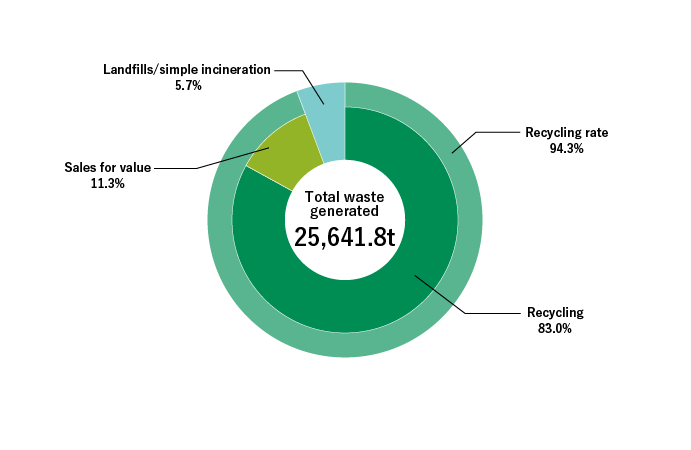
Breakdown of Waste Generated at New Housing Construction Sites (FY2023)
(Housing Division, Construction Business Sub-Division, Sumitomo Forestry Landscaping, Sumitomo Forestry Home Engineering)
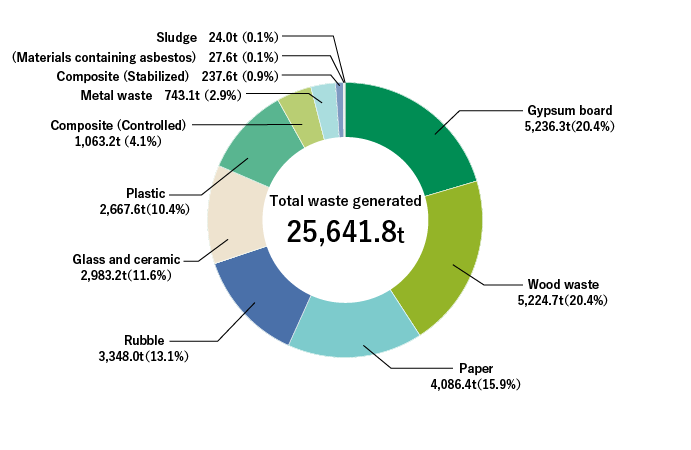
Efforts at Demolition Housing Sites
Sumitomo Forestry was promoting resource recycling even before the enactment of the Construction Material Recycling Law implemented in 2002 by ensuring that materials were properly sorted during demolition prior to the construction of a new house and that waste remained sorted for processing afterwards. Since the enactment in 2002, the Company has recycled the items required under the Law (wood waste, concrete, etc.), sorting them at the sites where the waste is generated. In recent years, demolition work of housing built using construction materials containing asbestos has increased, and revised law related to asbestos have also been enacted in 2020. Sumitomo Forestry especially strives for uncompromising compliance to removal method, processing guidance and management of construction materials containing asbestos.
The recycling rate for concrete was almost 100% in fiscal 2023, as it was the previous year. We also maintain a high recycling rate for wood waste by removing extraneous matter.
Waste Management for Demolition Work
We are strengthening management by building a system able to confirm the type, quantity and packaging of waste to transport from demolition work sites using mobile phones and smartphones which is adopted by our demolition partners.
Recycling rate at
housing demolition sites
96.6%
Breakdown of Demolition Waste Generated (FY2023)
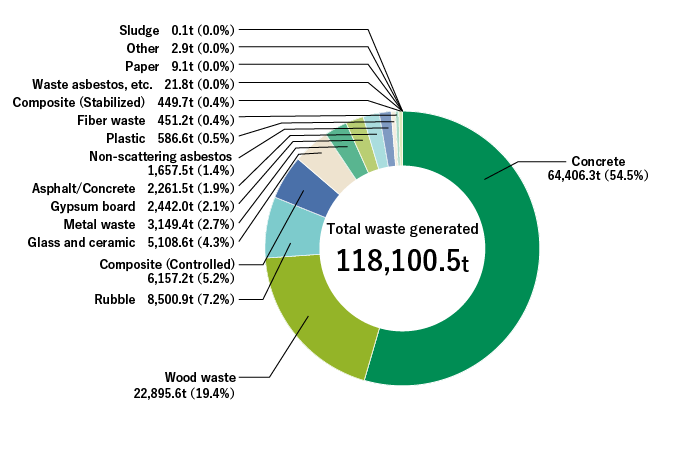
Launch of Industrial Waste Management Centers
Sumitomo Forestry opened three industrial waste management centers throughout Japan in fiscal 2021. We will work to eliminate industrial waste risks nationwide through unified and highly accurate management by personnel specializing in industrial waste management operations. These management processes include precise process confirmations and deadline management from electronic manifest registration of industrial waste produced throughout Japan through the final disposal obligations of the entity producing the emissions. These management practices strictly adhere to laws and regulations, such as checking information registered in the electronic manifest against the outsourcing contract and updates to outsourcing contracts.
Remodeling and Renovation Business Initiatives
We are working to reduce waste generated on remodeling and renovation sites by using reusable protective materials. Sumitomo Forestry Home Tech recycles wood waste materials generated at its renovation sites.
Our Group also strives to effectively use resources, such as the initiative to operate a material recycling route to reclaim wood waste from metropolitan areas as raw materials for particle board that started in fiscal 2014. In addition, we will provide focused guidance and education to sites with low recycling rates, strengthen sorting, and promote outsourcing to disposal sites with high recycling capacity.
Guidance on on-site sorting and enhanced sorting at disposal sites resulted in a recycling rate of 84.8% in fiscal 2023
Trends in Recycling Rates in the Renovation Business*
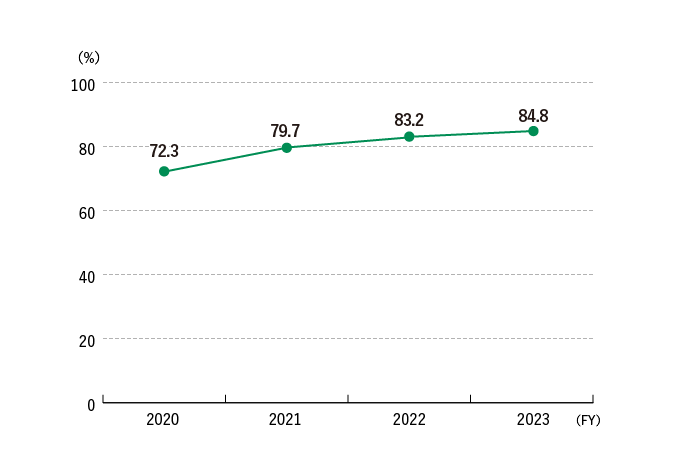
*Includes Sumitomo Forestry Home Tech renovation sites but excludes hard-to-recycle debris and asbestos
Breakdown of Waste Generated at Renovation Business Operations (FY2023)
(Sumitomo Forestry Home Tech)
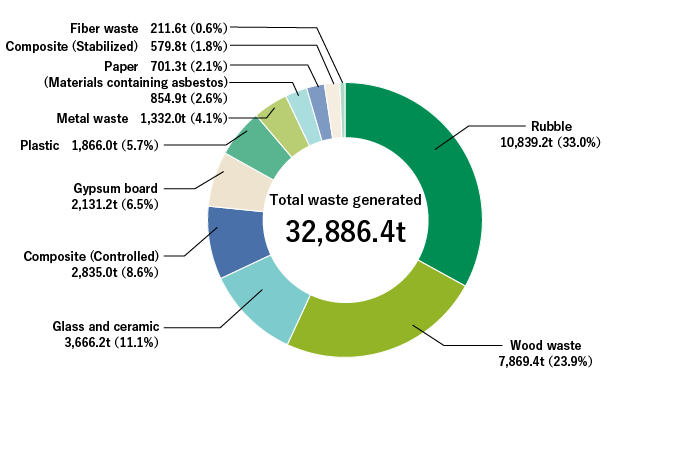
Work with Construction Contractors
Sumitomo Forestry publishes monthly safety, environment and quality inspection information that includes information and topics about safety and the environment to help avoid industrial waste-related risks by repeatedly raising awareness at branches and construction contractors.
Education for New Construction and Demolition Contractors
Sumitomo Forestry provides education to new construction contractors and conducts comprehension tests about industrial waste. Demolition contractors report about industrial waste to each office and branch from the start of demolition work to its completion as a construction management record according to a manual. Each office and branch verifies these construction management records and provides guidance for corrective actions if any inconsistencies are found.
- Home
- Sustainability Report
- Environment
- Resource Recycling Initiatives
- Waste Reduction and Recycling in the Housing Business

